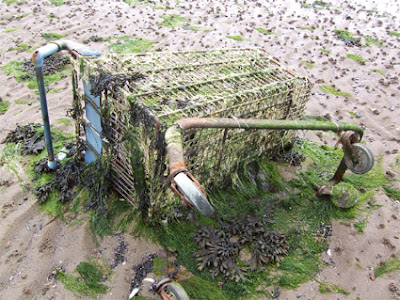
As all the tech trend round-ups of 2007 bounce about in articles on and offline generally citing 2007 as the 'Year of the Social Network', I wondered what next year's - or the one in five years' time (can't be precise about these things) - will be extolling.
I'm not a great believer in predicting stuff: there's just too much we can't know and there's randomness, but as a general feel for what might happen here goes.
I think it will be about how the web broke out, starting to slide from behind our screens and swirling deeper into the real world. This is not just mobile Internet. It's better.
The first major sign of this on a large scale is the fantastic Nike+. The Internet is not quite in your shoe but it's getting very close. Cut away the fact that the runner is informed by her iPod about all sorts of useful things (e.g. how fast she is going etc) and that the music it plays enhances the running experience and all the iPod is to the Nike+ system is a delivery boy, running messages between a shoe and the Internet.
With the advent of mobile-network enabled Internet or, even better, blanketed wireless Internet, this delivery boy is no longer needed. The Internet will be manifest in 'physical widgets', that is, real world objects augmented by their connection to the Internet. Something that sort of looks like this is Wattson, a sexy little physical widget that shows your energy consumption based on beamed data from your electricity meter.
This break out means that anything in the real world can be networked in. iPods already have; the iPod Touch is equipped with WiFi, allowing songs to be downloaded in a zone. One such zone is Starbucks, where songs playing in-store can be instantly downloaded as easily as buying a coffee. I have also written the possibility of 'kitchen widgets' here. These are essentially video recipe books that are creative by other users or pros and that could be made to sync with your grocery orders.
Outside of the house, your car will be able to update its hard drives before you set off for work, possibly adding your personalised news bulletins, recently customized iTunes playlists or tweaking the car's systems to be consistent with what it knows the weather will be like on the route you are going to take. In addition to this within-car wizardry, wireless blankets will allow between-car communication, calculating position, speed and host of other variables to possibly warn drivers about impending collisions. This is something being developed here.
Add to the wireless mix one more thing and the game changes again. If your physical widget knows where it is, this opens up a plethora of possibilities. Cars with the collision avoidance system I mentioned a second ago could factor in danger spots to improve saftey. People could create geo-playlists - songs linked to certain locations - and others could then walk in their musical vapour trails.
Similarly, cards in cameras will be dispensed and photos will take residence online as soon as they are snapped. Again, this is starting already. That particular kind of chip may be short-lived because cameras will have in-built wireless transmitters (this already exists in the form of the phone camera, it just hasn't gone vice versa yet).
The positions of photos taken can be recorded as well, allowing you to track back to the precise spot where you took it. Like geo-playlists, geo-slideshows could exist, where photographers could exhibit photos viewable on screens in certain locations (Flickr already have a rudimentary system in place for this, here, as do Google in Picasa Web.)
Perhaps the most exciting application of location aware photos is the possibility that hyperlinks can be built between them, allowing 3D models of the world to be built by millions of users. Microsoft are developing such a system called Photosynth.
Building on this is the very ripe area of geosearch. Here the physical world can be searched. Early versions of this are being actively researched. For example, a version of augmented reality using a mobile phone has been developed by Nokia here. In this GPS and orientation sensors dance together to allow buildings to be recognised via the camera.
The vision in my mind of how this will turn out is holding your camera up to a street and seeing in the overlay directions to your destination or the result of your search highlighted. Something like this:

This sort of thing will inevitably lead to (potentially very useful or spammy) location-sensitive advertising exploding out. Hungry? The sponsored links in the overlay will direct somewhere tasty, maybe even telling you today's specials. Google are understandbly excited about this and reckon that mobile ad revenue will be well over $1bn by 2012 (source: Financial Times).
So this is where I think the biggest trend in technology will be found in 2008 - the Internet unleashed and bursting out of screens. Probably, 2008 will only be the start of all that and much of the stuff I mentioned here will likely come later.
And if you'll let me be fanciful and imagine the logical endpoint of this expansion, I'd say it will be neurally accessible Internet. Where we can call upon the Internet in the same way we call upon a memory and where there is the potential to affect other perceptual systems. Where is the shop again? We could literally see it subtly highlighted in our vision, dispensing with the need for the mobile phones I mentioned earlier. But that's for another blog. Brain-Internet interfaces are a long way off but the Internet moving beyond its confines in the screen is not.




















